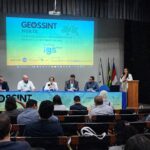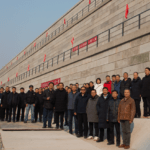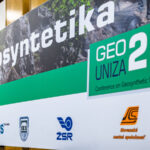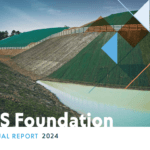Education is key to helping the geosynthetics industry thrive, according to Jonathan Shamrock, Vice President of the Australasian chapter of the IGS (ACigs) and Chairman of the Technical Committee on Barrier Systems (TC-B). Here, he shares his thoughts about the challenges and opportunities facing geosynthetics, recent highlights in his busy roles, and the words of wisdom he swears by.
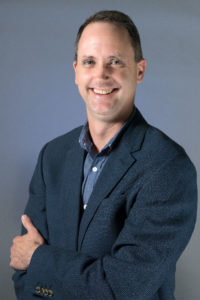
Please tell us a bit about your involvement with the IGS.
I am currently Vice President of ACigs and Chairman of the IGS Technical Committee on Barrier Systems (TC-B), both roles of which I started in September 2020.
Previously I was TC-B Secretary following the International Conference on Geosynthetics in Seoul in September 2018 and was ACigs’ New Zealand representative from 2019.
Both of your current roles sound demanding. Can you share a little about your aims in each role, highlights and forthcoming events?
The main aim of both roles is very similar, and links to the mission of the IGS, which is about providing opportunities for education and understanding in the use of geosynthetic products.
The TC-B is dedicated to the scientific and engineering development of geosynthetic barrier systems and associated technologies, which aligns with my main area of work and is thus very personal to me.
ACigs is my local chapter and as such deals with issues relevant to the region I work in. It allows members to be informed about, and participate in, local and regional activities in addition to providing access to the resources and international dimensions of the IGS. Both committees are comprised of passionate volunteers who give their time to realise the IGS mission.
Looking back to pick out highlights of my involvement made me realise it’s been a busy few years. For ACigs its was helping to organise a one-day seminar in New Zealand, delivered by Professor Timothy D. Stark, that was linked to the IGS Educate the Educators programme that was held in Australia after this. This programme is a key initiative as it gives university lecturers the tools and materials to introduce geosynthetics teaching at undergraduate level. Another highlight was assisting the ACigs committee to get our webinar series off the ground in late 2019, initially as a way to cater for events that could reach the large geographic spread of our member base. We certainly did not think that these would become the main form of member engagement during Covid times.
For the TC-B, highlights were assisting with the organisation and presentation of the TC-B workshop in Barcelona in January 2020 called ‘GeoBarrier Developments, Advancements, Durability, Performance, and Innovations’. Looking back you realise what a privilege it was to be able to have an in-person event with delegates from all over the world and the impact the unprecedented year, that was to follow our return from the workshop, would have on the world. For the TC-B it was also helping get its webinar series going in 2021, focussing on specific technical topics related to geosynthetic barrier manufacturing, installation and performance.
In terms of upcoming events I am very excited to be leading the Technical Committee for the upcoming inaugural ACigs GeoANZ#1 conference in June this year, our first in-person event since the start of the Covid pandemic. The TC-B committee is committed to organising the next workshop session, once worldwide travel has returned to more certain schedules, so watch this space.
How has the IGS evolved since you joined?
I have only been directly involved with the IGS since 2018, so am relatively new to the society. Prior to emigrating to New Zealand in 2018 my main professional society involvement was with the Institute of Waste Management of Southern Africa (IWMSA). The IWMSA held many joint events with the IGS’s South Africa chapter, known as the Geosynthetics Interest Group of South Africa (GIGSA), so I had a good understanding of the IGS, and the work they did, and I personally benefitted enormously from many excellent international speakers GIGSA brought out to events in South Africa. I was also fortunate in that the company I worked with in South Africa supported involvement in professional organisations, and I was privileged to work with a few of the past presidents of GIGSA at that company.
What is your role outside the IGS?
I am a Technical Director at Tonkin & Taylor Ltd in New Zealand, an environmental and engineering consultancy, and have more than 25 years’ experience working in the field of solid waste engineering. My main interests include design and construction supervision of general, industrial and hazardous waste landfill developments and barriers, design and construction supervision of waste facility capping barriers and stormwater management facilities, design incorporating geosynthetic materials including specifications and construction quality assurance and design and construction supervision of landfill gas extraction, conveyance and destruction systems.
My experience up to 2017 was in South Africa and Africa, working in the same field, where I worked for Jones & Wagener Ltd, also an environmental and engineering consultancy, until I immigrated to New Zealand in 2018.
How has the industry changed and how do you see it developing?
Working in geosynthetics is always exciting, as there is a constant flow of new materials, new products and new research that impacts the way we use these materials in our designs. It is an area of rapid innovation, and that links directly to the mission of the IGS to support good education on the appropriate use of these products.
Having said that, some basic concepts will always apply, and I am grateful to my mentors in the industry who passed on their knowledge to me. They also left me with some sage words of wisdom which I in turn pass on to new people entering the market, things like, “Trust no one, test everything” and “People don’t do what’s expected, they do what’s inspected”.
What do you think will be the challenges and opportunities for the industry over the next few years?
In terms of the IGS, I think it will be figuring out what is the new normal post-Covid, and how to best deliver the educational messages we have to our target audience. I believe one of the few positives from the travel restrictions imposed by governments due to Covid was the move to virtual webinar sessions for a lot of the content that would have typically been presented at conferences, which is reliant on in-person attendance. This is now starting to form into an excellent library of knowledge on geosynthetics, delivered by world experts, that is accessible at any place and at any time, to people around the world who may not have the means to attend the in-person events, but who can definitely benefit from being exposed to the content.
What do you think are the current key priorities for the geosynthetics industry, and why?
Going back to the IGS mission it is education on the myriad geosynthetic products on the market, and their appropriate use. Another key priority is education about the sustainability benefits of using geosynthetics, which often provide cheaper, more resilient, and more sustainable solutions compared to traditional construction methods, but which are often met with resistance because of “this is not the way we have traditionally done this” thinking.
What do you enjoy the most about being involved in the IGS?
The fact that you have to stay abreast of the latest developments, and that everyone is always striving to do things better and figuring things out as they go along. The TC-B workshop session in Barcelona was an example of this – four or five short presentations on a topic and then an equal amount of time for questions and open discussion. Unfortunately, you often don’t know what you don’t know, and attending events like this is the best way to fill in those gaps, and to meet and interact with the people doing the research on the products and applications in the academic or commercial fields.
It is also a lot about the people you get to interact with, and their willingness to give freely of their time and to help with the ongoing educational drive of the society is humbling.
What are you most looking forward to in the IGS calendar?
The ACigs GEOANZ#1 conference in June 2022 and the next ICG in Rome in September 2023 where the TC-B is planning on having a dedicated barrier session.
Do you have any messages for members?
Get involved in any of the IGS TCs where your interests lie – Barrier Systems, Hydraulic Applications, Soil Reinforcement or Stabilization, or your local chapter committees. They provide excellent opportunities for learning, which in this industry is ongoing, and for networking and meeting people who share a common passion and belief that geosynthetics can help tackle many aspects of developing the world sustainably.
Find out more about the IGS Technical Committees here.


